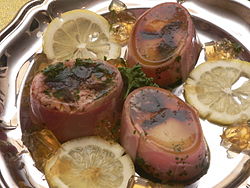Gelatin
Gelatin is a protein substance that comes from collagen.[1] Collagen is a natural protein found in the tendons, ligaments, and tissues of mammals as well as fish. Gelatin has no smell, no taste, and is either colorless or light yellow. It can be found in sheets, flakes, or as a powder. It can be dissolved in water, but not in alcohol.
It is made by boiling the connective tissues, bones and skins of animals, usually cows and pigs. Once the boiling is done, the collagen will cool and make a jelly. As a food, gelatin is used to make jellied desserts; used in the preservation of fruit and meat, and to make powdered milk. Gelatin can also be used as glue for matches or for paper money. You can also find it used as the syrup in medicine, also known as medicine emulsions. Gelatin is also found in some makeup.
Gelatin is classed as a liquid when above room temperature but reverts to a solid if below room temperature.
Because gelatin comes from animals, vegetarians and vegans do not eat or use products that have gelatin added. Some religious or cultural groups also do not eat gelatin because of the animals used to make it. For example, people that keep kosher or halal will not eat gelatin because it is often made from cows. Alternatives to gelatin are products like agar or carrageenan which comes from seaweed or pectin which comes from plants.
Gelatin Media
Amino acid composition
[source?]
Congealed into jelly gelatin of boiled fish with soy sauce and kept around at 8 °C. In Japan, it is called 煮凝り (Niko-gori), literally 'boiled then become flocculated/stiffened'. Not intended cooking, occurs naturally in winter, historically tasted.
References
- ↑ Ward A.G. & Courts A. 1977. The science and technology of gelatin. New York: Academic Press. ISBN 978-0-12-735050-9
+{{{1}}}−{{{2}}}





